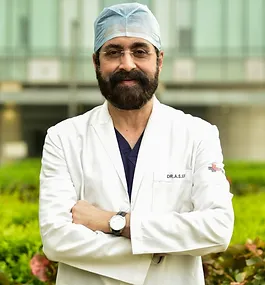Liver transplant is often spoken of as a last hope for patients with severe liver disease. But when the patient is a child, the entire story changes. A paediatric liver transplant is not just a smaller version of an adult surgery — it is a completely different world, filled with unique medical, ethical, and emotional challenges.
For families, the idea of putting a child through such a complex operation is overwhelming. For surgeons, it demands the highest skill and precision. Few surgeons worldwide have the expertise in this delicate area. In India, Dr. A.S. Soin, one of the most experienced liver transplant surgeons, has led the field in paediatric liver transplantation with results matching the best centres in the world.
This article explores how liver transplant for children differs from adults, why it is needed, what outcomes to expect, and why expert care makes all the difference.
Table of Contents
ToggleWhy Children Need Liver Transplant
Adults mostly require a liver transplant because of long-term cirrhosis due to hepatitis B, hepatitis C, alcohol, fatty liver disease, or cancer. In children, the story is very different.
The most common causes of paediatric liver transplant are:
- Biliary atresia – a condition where bile ducts are absent or blocked from birth. It is the single largest reason for liver transplant in infants.
- Metabolic liver diseases – disorders where enzymes are missing, leading to toxic build-up.
- Acute liver failure – viral infection, drug reaction, or unknown reasons causing sudden failure.
- Genetic and congenital liver conditions – rare but severe disorders affecting function.
So, unlike adults, where lifestyle and acquired diseases dominate, in children, most causes are congenital or genetic. This is what makes child liver transplant surgery such a specialised area — the anatomy, size, and needs of the patient are totally different.
When to Consider Liver Transplant in Children
Parents often wonder: When is the right time to go for a transplant? Doctors look at both medical and quality-of-life indicators.
Some signs that suggest the need for a child liver transplant surgery include:
- Growth failure (child not gaining height or weight as expected)
- Severe jaundice that doesn’t improve with treatment
- Uncontrollable itching, making life miserable
- Repeated episodes of infection or internal bleeding due to liver failure
- Fluid in the abdomen (ascites) not improving with medicines
Making this decision is never easy. That is why consulting an experienced paediatric liver transplant surgeon like Dr. A.S. Soin becomes crucial. Early referral often means better outcomes.
The Donor Difference: Living Donor Advantage
In adults, deceased donor transplant (from brain-dead donors) is a major source. In children, suitable deceased donors are rare because organ size has to be matched. A huge adult liver cannot be placed in a 6-kg infant.
Here is where a living donor liver transplant becomes the main option. A portion of the liver, usually the left lateral segment (about 20–30% of the total liver), is taken from a parent or close relative and transplanted in the child.
- Size match is critical. A liver too large may compress vessels; too small may not support growth. Surgeons measure volumes carefully.
- Blood group matching is important, though in infants, sometimes even an ABO-incompatible transplant can be managed with special treatment.
- Parent donors often come forward. Unlike in adults, where extended family or unrelated donors may be seen, in children transplant it is usually mother or father.
So in paediatric transplantation, family participation is much more central.
https://deparh.khm.gov.ua/
Surgical Complexity
The technical side of the surgery differs greatly.
- Tiny blood vessels – In a 6-month-old baby, the portal vein can be as small as 3 mm. Stitching such vessels requires micro-surgical skills under high-powered magnification. Any clot or narrowing can quickly block blood flow.
- Size matching of graft – Surgeons calculate the graft-to-recipient weight ratio. If the liver portion is too big, it may cause abdominal compartment syndrome; too small, it may fail.
- Biliary anastomosis – In children, bile ducts are extremely narrow and delicate. Leakage or stricture can cause major complications. Surgeons often connect the bile duct directly to the intestine (Roux-en-Y hepaticojejunostomy).
- Blood loss – Even a few millilitres matter. For a child weighing 8 kg, 100 ml blood loss is huge. An experienced team with excellent anaesthesia is needed.
So technically, paediatric liver transplant is considered one of the most demanding procedures in medicine. Experienced surgeons like Dr. A.S. Soin and his team have performed thousands of such procedures, carefully managing challenges like blood vessel size, graft matching, and bile duct reconstruction. This expertise is what determines success and long-term recovery in children.
Growth and Development Factor
For children, a transplant is not just about survival; it is about normal growth. After a successful transplant, many children who were stunted or underweight catch up with their peers in height and development.
This is different from adults, where a transplant is about survival and quality of life, not physical growth. In paediatric liver transplant outcomes:
- Nutritional rehabilitation is critical. Dieticians work to restore weight and muscle.
- Brain development improves once toxins are removed from the body.
- Schooling and social integration become part of the care plan.
Thus, paediatric transplant is not just medical; it is also developmental.
Immune System Considerations
Children’s immune system is immature and reacts differently from adults. This influences the choice and dose of immunosuppressants after child liver transplant. At the same time, the challenge is to keep the immune system calm enough not to attack the new liver, but active enough to fight normal infections.
- Some studies show children can sometimes “tolerate” a transplanted liver better, needing lower long-term doses.
- But they are also more vulnerable to infections, especially in the first year.
- Vaccination schedules need to be adjusted. Many vaccines cannot be given during heavy immunosuppression.
Long-term compliance is also a challenge. A 5-year-old cannot remember to take medicines. Parents shoulder that responsibility. When the child grows into a teenager, education about adherence becomes vital.
Psychological and Family Burden
An adult transplant affects one individual and their spouse or family. Paediatric transplant affects the whole household in a deeper way.
- Parents often become both donors and caregivers. It also brings fear about donor safety.
- Siblings may feel neglected as attention focuses on the sick child.
- Financial and emotional stress are high because treatment is prolonged.
This family dimension is unique to the paediatric liver transplant journey. The surgeon’s team often includes psychologists and counsellors to guide families.
Long-Term Outlook
The good news is – children often do better than adults in the long run.
- Survival rates for children can reach 85–90% at 5 years in good centres.
- Because they are young, the transplanted liver grows with them. Unlike the heart or kidney, where a graft may need replacement, the liver expands as the body grows.
- Many children go on to live normal adult lives, study, marry, and even have families of their own.
In contrast, adults often face recurrence of disease (like hepatitis or alcohol relapse). Children rarely face that issue.
Moreover, the long-term success depends on:
- Early referral and timing of transplant
- Proper donor selection
- Strict follow-up and medicine adherence
- Expertise of the surgical team
Dr. A.S. Soin and his team have performed some of the highest numbers of successful paediatric liver transplants in India, with outcomes comparable to the best global centres.
Risks and Complications in Children
Every transplant has risks, but children have some unique ones:
- Vascular blockages (clotting of tiny blood vessels)
- Bile duct complications due to a narrow size
- Infections because of weaker immunity
- Rejection episodes, more common in younger patients
However, with modern surgical techniques, vigilant monitoring, and prompt intervention, most complications can be managed effectively.
Unique Challenges in Adolescence
As transplanted children become teenagers, new issues arise:
- Non-adherence – Teenagers sometimes skip medicines, leading to rejection.
- Body image – Scars or small stature may affect confidence.
- Transition to adult care – Moving from paediatric to adult transplant clinic requires planning.
These problems are less in adults who are already responsible for themselves. In children, doctors must work with families to prepare for adolescence.
Ethical Aspects
Ethics around paediatric transplant are different too:
- Consent – A child cannot give informed consent; parents decide. Surgeons must balance parental decisions with the child’s best interests.
- Living donor risk – Asking a healthy parent to undergo major surgery for their child is emotionally loaded.
- Allocation – In countries where cadaveric organ donation exists, priority for children is often higher, as they have more life years to gain.
These are sensitive situations, but paediatric liver transplant is one area where the benefits are so transformative — giving a child the chance of a full, long life — that most ethicists support it strongly.
Special Innovations in Paediatric Transplant
To meet the unique demands of children, some surgical innovations have been developed:
- Reduced-size grafts – A portion of the adult liver trimmed to fit a child.
- Split liver transplant – One deceased donor liver divided into two: a smaller part for a child, a larger for an adult.
- Auxiliary transplant – Sometimes, part of the liver is added to the child’s body, allowing the native liver to regenerate.
- Newer immunosuppressants – safer drugs with fewer long-term side effects.
These techniques are less common in adult practice but widely used in paediatric surgery.
Outcome Beyond Medicine
One of the most heartening parts of paediatric transplant is how it transforms the entire family life. Parents who spent months in the hospital suddenly see their child walk, eat, and laugh again. This psychological reward is special in children, more than adults.
At the same time, the stress is also heavier. Parents must cope with uncertainty, repeated hospital visits, financial burden, and constant fear of infection. A supportive transplant team makes all the difference.
Final Word
Liver transplant in children is one of the most complex but also most rewarding areas of modern medicine. For surgeons and families alike, it demands courage, patience, and commitment. The differences from adult transplantation are profound – not just in medical technique but also in emotional, ethical, and developmental aspects.
Every successful paediatric liver transplant is not only a life saved, but also a life restored to its full potential. If your child has been advised a liver transplant, it is crucial to consult an experienced liver transplant surgeon. With decades of expertise and outcomes matching the best in the world, Dr. A.S. Soin provides comprehensive care for children needing a liver transplant.








